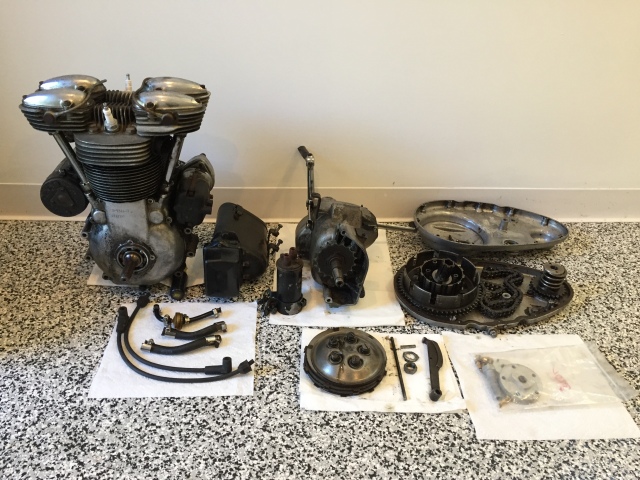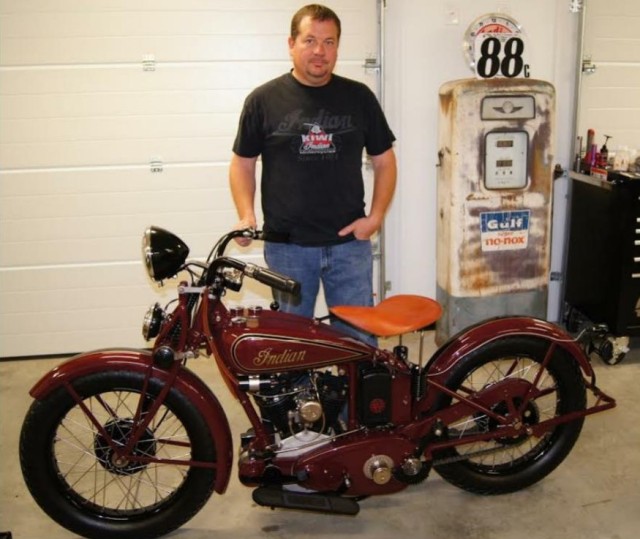It will take a while to reconstruct what I’ve learned and gathered over the past 20-ish months. A while just to get to it. So I thought I should maybe begin with where we are at the moment. You know, in case I get hit by a bus. Survivors will surely ask: is the bike all right? Second order of business: where’s the rest of the bike and what did the poor feller intend to do with it.
When I bought the bike, it was for the most part a fully functioning machine. It started. It also ran for about 5 seconds. This was done for me by the previous owner, Fred Todd of Truro, MA, the day I picked it up with the help of my cousin Joe. Cousin Joe is a retired auto mechanic approaching his 70’s. Or is 70; I forget. Joe built a few hot rods in his day. Still owns one. A Willys Coupe, I believe.
I should have asked Fred to let one of us ride it — just a little — to see if the rest of the drive train worked and if the motor would run for longer than 5 seconds. I was so excited that it ran at all, that I forgot about any of those other sensible things. He did push the horn button and lit the headlight and brake light. All of which worked. He was also in his 70’s and was selling the bike because “I just don’t have time to tinker with it anymore.” He seemed pretty happy to see me so happy about the bike and could tell that I was going to take care of it well, going to a good home, and so forth. Anyway, Cousin Joe blessed the purchase, I gave Fred a bank check, and the three of us huffed the bike into the back of Joe’s truck. The bike only weighs about 300 lbs dripping wet. Fred gave us a bill of sale and a title for the bike and a 1951 Massachusetts motorcycle license plate; painted in “Trials Scarlet” red that matched the bike’s paint. Oh, and Fred gave me all of his Indian motorcycle magazines and a couple of handy restoration books. About a month later he sent me a spare fender he had acquired. It wasn’t for this model bike (oddly, it has a VW tail light integrated – someone suggested it may be a Von Dutch creation), but awfully nice of Fred to send that to me, at his expense and time, no less. Just recently, he sent me a couple more Indian books he found. Also at his expense. This has been happening a lot. Not just with Fred. I don’t know if it’s an Indian thing, but I’ve been more than presently surprised by the generosity of the handful of people I’ve met while doing this. I don’t actually ask for things, they just volunteer them — whether it’s advice, old documents, photographs; you name it. More on that in future posts.
At the moment, however, the bike is a little better than a basket case. I disassembled much of the bike in early October of this year in order to remove the motor and transmission. I decided early on that I’d like to ride this bike occasionally and not have to worry (too much) about breaking down or having a hard time starting it (mostly the latter). To me, that meant getting the whole bike rebuilt and tuned-up to like-new condition — as best as can reasonably done — internally, mechanically, ‘lectrically. Not interested in a museum quality restoration — those are great, just not my thing. Anyway, I wanted to find someone who knew what they were doing with a motor cycle motor rebuild, and, ideally, if they knew Indians; these Indians.
There is a small user-group on Yahoo that I found early on, that is so narrow it is dedicated to only the Indian “verticals” — a line of later Indian bikes which mine happens to be a part of. Indian developed the “vertical twin” motor line in 1949. Of that line, 1950 was the year the Warrior line was introduced — to compete with the smaller Japanese and British bikes that were becoming very popular and presenting stiff competition in sales numbers and in the racing world. The Indian Motorcycle company went out of business in 1953 — for various reasons. Many Indian enthusiasts blame much of the downfall of the company on the poorly-managed development of the Warrior line. There were only about 3,000 Warriors ever made; of 1951 TT’s — maybe 1,000. Since the TT’s were enduros (the only reason to buy this model instead of the Street Warrior was to use them as enduros) I imagine they were run pretty hard and not many survive to this day. You get a sense of this from the lack of availability of certain parts – such as rear fenders and chain guards which either racers removed because they got clogged up with mud, they rotted, or guys just discarded them the day they brought them home to avoid mud and rotting in the first place. There are at least 2 or 3 as-original, low-miles TT’s in collectors hands that I know of. It’s kind of a mystery how many just in general, in any condition, are still out there. I’m going to guess maybe 50 to 100 TT’s are left from the 3 years Indian made them.
A few days after I got the bike home, I tried like hell to start it, even followed the short list of instructions Fred gave to me (I think the battery was not quite up to snuff; and the kick start lever a little bent — and oddly — to what I’m used to being a “righty” — is on the left side of the bike). I posted a message on that Yahoo group I found some days later — looking for someone to rebuild my motor. I got one reply. Seemed like a good price, so after working out some details, I shipped him the motor and transmission and everything else he needs to start it and test it too, in late October of this year.

Left to Right: My 1951 TT motor, magneto, transmission, primary case, ‘cetera… (Everything I sent to Wally — not in photo: 275 AMAL carb). Careful lookers: the motor is engraved with a mystery man’s name: “CURTISS”. I assume it’s a man; women are too smart for this.

Wally Brown, Jr. and his ’33 Indian Scout Pony

Definitely in good hands – that is a beautiful piece of machinery!
LikeLike
Ain’t she grand?
LikeLike
That’s a beautiful engine. As to generosity of tribal members, I see it in the old machine tool tribe as well. Many just want to see their machines go to good homes and are often very generous.
LikeLike
Thanks, John.
I asked Wally not to pollish the motor or any of the externals. It only looks like this once.
LikeLike